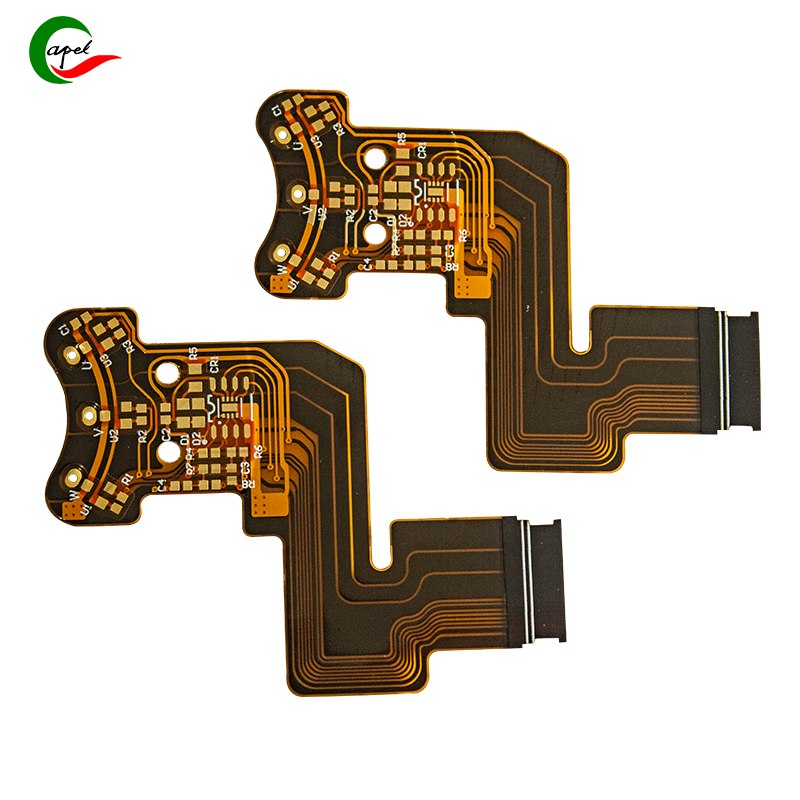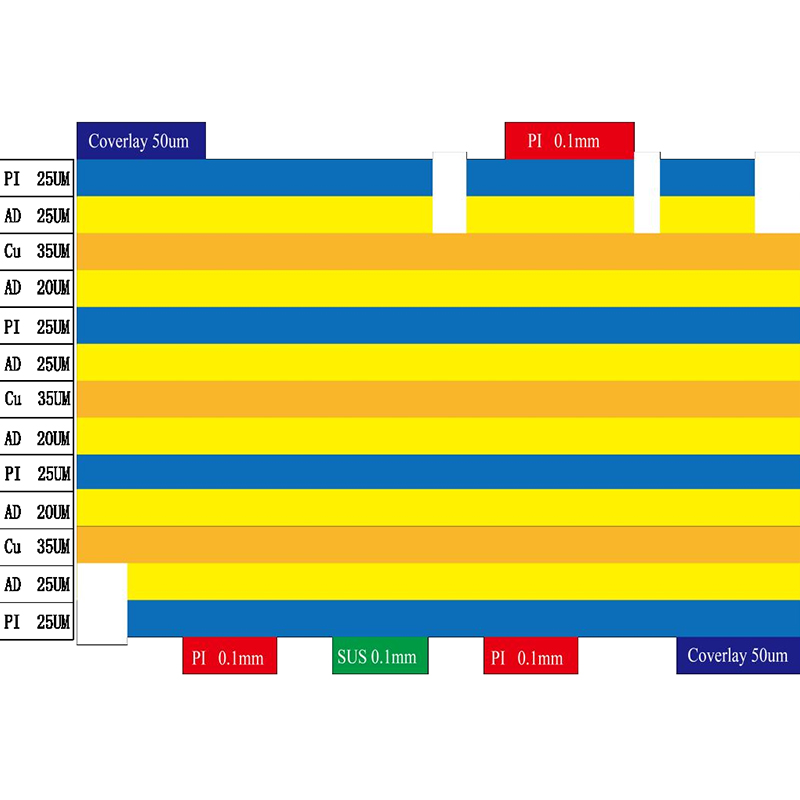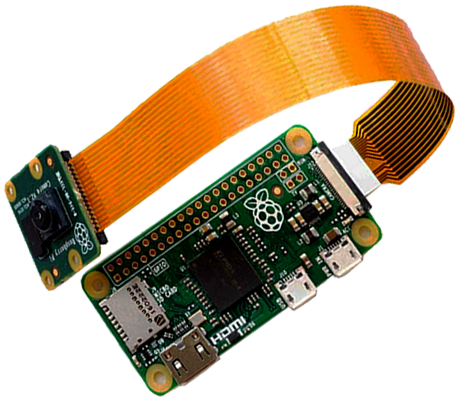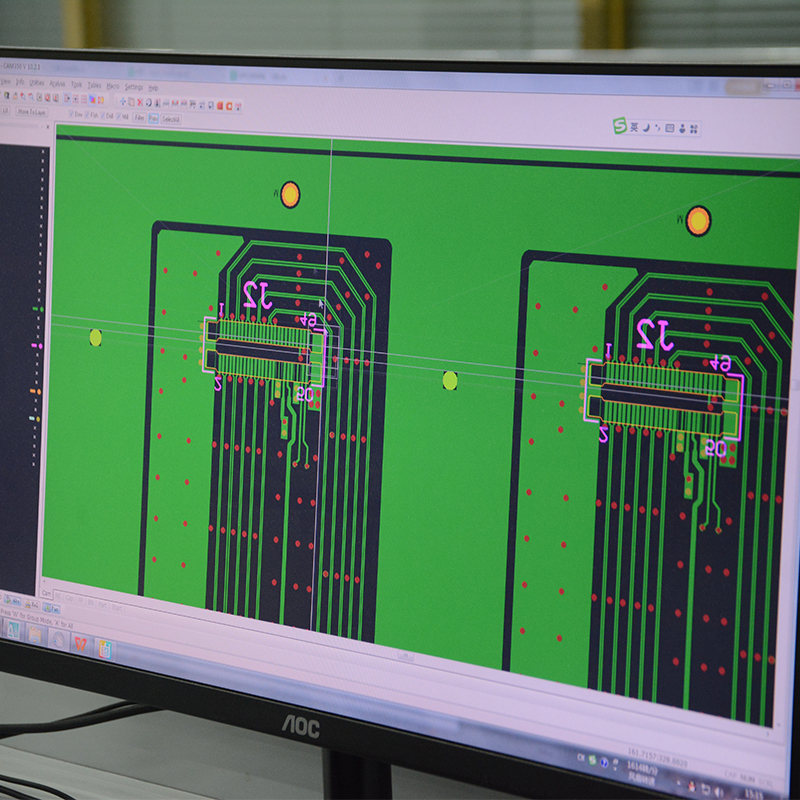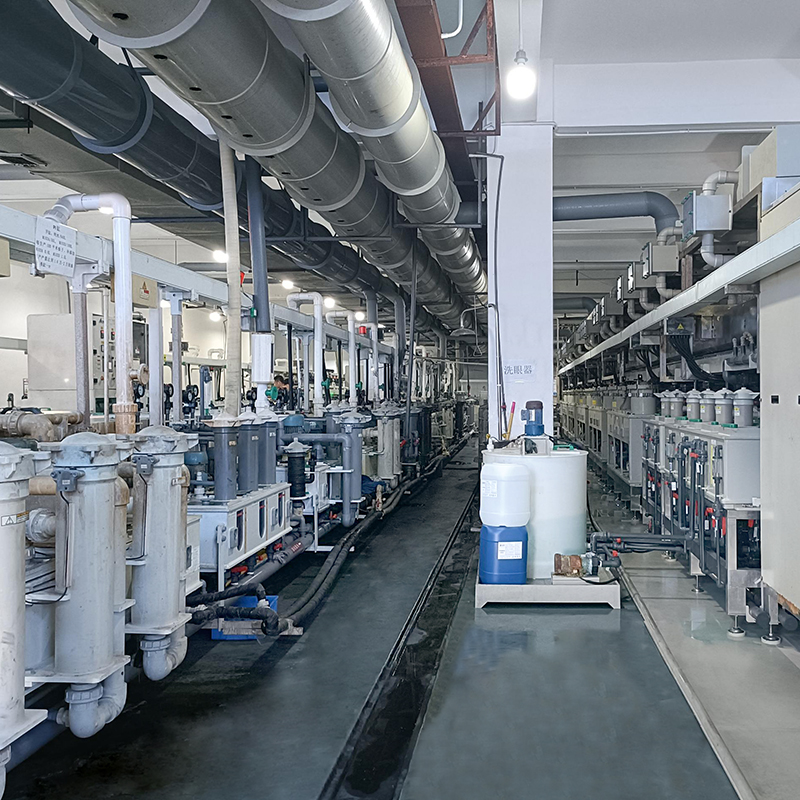Flexible circuit boards, also known as flexible circuits or flexible printed circuit boards (PCBs), have revolutionized the electronics industry by replacing rigid and bulky traditional PCBs. These innovative electronic marvels have gained popularity in recent years for their unique features and applications. This article aims to provide beginners with a comprehensive guide to flexible circuit boards – their definition, structure, advantages, applications, and future trends in this technology. After reading this article, you will have a clear understanding of how flex circuit boards work and their advantages over rigid circuit boards.
1.What is a flexible circuit board:
1.1 Definition and overview:
A flexible circuit board, also known as a flexible circuit or a flexible printed circuit board (PCB), is an electronic circuit board that is flexible and bendable, allowing it to adapt to various shapes and contours. Unlike traditional rigid PCBs, which are made of rigid materials like fiberglass or ceramics, flex circuits are made of thin, flexible materials like polyimide or polyester. This flexibility allows them to fold, twist or bend to fit tight spaces or conform to complex geometries.
1.2 How does a flexible circuit board work:
A flexible circuit board consists of a substrate, conductive traces, and layers of insulating material. Conductive traces are patterned onto the flexible material using different techniques such as etching or printing. These traces act as paths for current flow between different components or parts of the circuit. Flexible circuit boards work like traditional PCBs, with components such as resistors, capacitors, and integrated circuits (ICs) mounted on the board and connected using conductive traces. However, the flexibility of flex pcb allows them to be bent or folded to fit tight spaces or conform to the shape of a specific device or application.
1.3 Types of flexible circuit boards:There are several types of flexible circuit boards, each designed to meet specific application needs:
1.3.1 Single-sided flexible circuit:
These circuits have conductive traces on one side of the flexible substrate. There may be an adhesive or protective coating on the other side. They are often used in simple electronics or where space is limited.
1.3.2 Double-sided flexible circuits:
Double-sided flex circuits have conductive traces on both sides of the flexible substrate. This allows for more complex circuit designs and increased component density.
1.3.3 Multilayer flexible circuits:
Multilayer flex circuits consist of multiple layers of conductive traces and insulating materials. These circuits can support complex designs with high component density and advanced functionality.
1.4 Commonly used materials for flexible circuit boards: Flexible circuit boards are manufactured using a variety of materials depending on the specific requirements of the application. Some commonly used materials include:
Polyimide (PI):
This is a popular choice for flexible circuit boards due to its excellent temperature resistance, chemical resistance and dimensional stability.
Polyester (PET):
PET is another widely used material known for its flexibility, economy, and good electrical properties.
PTFE (Polytetrafluoroethylene):
PTFE was chosen for its excellent electrical insulating properties and high thermal stability.
Thin film:
Thin film flexible circuit boards use materials such as copper, aluminum or silver, which are deposited on flexible substrates by vacuum deposition technology.
2.Construction of flexible circuit boards:
The construction of flexible printed circuit involves the specific selection of substrate materials, conductive traces, protective coatings, coverlays, components and mounting techniques, and connection areas and interfaces. These considerations are critical to ensuring the flexibility, durability, and functionality of flex circuits for a variety of applications.
2.1 Substrate material:
The substrate material of a flexible circuit board is a key component that provides stability, flexibility, and electrical insulation. Common substrate materials include polyimide (PI), polyester (PET), and polyethylene naphthalate (PEN). These materials have excellent mechanical properties and can withstand high temperatures, making them suitable for most applications.
The choice of substrate material depends on the specific requirements of the circuit board, such as flexibility, thermal resistance and chemical resistance. Polyimides are generally favored for their superior flexibility, while polyesters are favored for their cost-effectiveness and good electrical properties. Polyethylene naphthalate is known for its excellent dimensional stability and moisture resistance.
2.2 Conductive traces:
Conductive traces are paths that carry electrical signals between different components on a flex circuit board. These traces are usually made of copper, which has good electrical conductivity and excellent adhesion to the substrate material. Copper traces are patterned onto the substrate using techniques such as etching or screen printing. In some cases, to enhance circuit flexibility, copper traces can be thinned through a process called selective thinning or microetching. This helps relieve stress on the flex circuit during bending or folding.
2.3 Protective coating:
To protect the conductive traces from external factors such as moisture, dust or mechanical stress, a protective coating is applied to the circuit. This coating is usually a thin layer of epoxy or a special flexible polymer. The protective coating provides electrical insulation and increases the durability and service life of the circuit. The choice of protective coating depends on factors such as temperature resistance, chemical resistance and flexibility requirements. For circuits that require high temperature operation, special heat-resistant coatings are available.
2.4 Overlay:
Overlays are additional layers placed on top of flex circuits for protection and insulation. It is usually made of a flexible material such as polyimide or polyester. Covering helps protect against mechanical damage, moisture ingress and chemical exposure. The coverlay is typically bonded to the flex circuit using an adhesive or thermal bonding process. It is important to ensure that the overlay does not limit the flexibility of the circuit.
2.5 Components and mounting techniques:
Flexible circuit boards can hold a variety of components including resistors, capacitors, surface mount devices (SMDs) and integrated circuits (ICs). Components are mounted on the flex circuit using techniques such as surface mount technology (SMT) or through-hole mounting. Surface mount components are soldered directly to the conductive traces of the flex circuit. The leads of through-hole components are inserted into holes in the circuit board and soldered on the other side. Specialized mounting techniques are often required to ensure proper adhesion and mechanical stability of flex circuits.
2.6 Connection areas and interfaces:
Flexible circuit boards typically have connection areas or interfaces where connectors or cables can be attached. These connection areas allow the flex circuit to interface with other circuits or devices. Connectors can be soldered or mechanically attached to the flex circuit, providing a reliable connection between the flex circuit and external components. These connection areas are designed to withstand mechanical stress over the life of the flex circuit, ensuring reliable, continuous operation.
3.Advantages of flexible circuit boards:
flexible circuit boards have many advantages including size and weight considerations, enhanced flexibility and bendability, space utilization, increased reliability and durability, cost-effectiveness, easier assembly and integration, better heat dissipation and environmental benefits. These advantages make flexible circuit boards an attractive choice for various industries and applications in today’s electronics market.
3.1 Dimensions and Weight Notes:
In terms of size and weight, flexible circuit boards have significant advantages. Unlike traditional rigid circuit boards, flex circuits can be designed to fit into tight spaces, corners, or even folded or rolled up. This enables electronic devices to become more compact and lightweight, making them ideal for applications where size and weight are critical, such as wearable technology, aerospace and automotive industries.
By eliminating the need for bulky connectors and cables, flex circuits reduce the overall size and weight of electronic assemblies, enabling more portable and stylish designs without compromising functionality.
3.2 Enhanced flexibility and bendability:
One of the main advantages of flexible circuit boards is their ability to bend and bend without breaking. This flexibility allows the integration of electronics into curved or irregularly shaped surfaces, making it suitable for applications requiring conformal or three-dimensional designs. Flex circuits can be bent, folded and even twisted without affecting their performance. This flexibility is particularly beneficial for applications where circuits need to fit into limited spaces or follow complex shapes, such as medical devices, robotics, and consumer electronics.
3.3 Space Utilization:
Compared with rigid circuit boards, flexible circuit boards have higher space utilization. Their thin and light nature allows efficient use of available space, allowing designers to maximize component utilization and reduce the overall size of electronic devices. Flexible circuits can be designed with multiple layers, enabling complex circuitry and interconnections in compact form factors. This feature is especially beneficial in high-density applications, such as smartphones, tablets, and IoT devices, where space is at a premium and miniaturization is critical.
3.4 Improve reliability and durability:
Flexible circuit boards are highly reliable and durable due to their inherent mechanical strength and resistance to vibration, shock and thermal cycling. The absence of solder joints, connectors and cables reduces the risk of mechanical failure and increases the overall reliability of the electronic system. The flexibility of the circuit also helps absorb and distribute mechanical stress, preventing fracture or fatigue failure. In addition, using a flexible substrate material with excellent thermal stability enables reliable performance even under harsh operating conditions.
3.5 Cost-effectiveness:
Compared with traditional rigid circuit boards, flexible circuit boards can save costs in several ways. First, their compact size and lightweight nature reduce material and shipping costs. Additionally, the elimination of connectors, cables, and solder joints simplifies the assembly process, reducing labor and production costs. The ability to integrate multiple circuits and components onto a single flex circuit board also reduces the need for additional wiring and assembly steps, further reducing production costs. Additionally, the flexibility of the circuit allows for more efficient use of available space, potentially reducing the need for additional layers or larger circuit boards.
3.6 Easier to assemble and integrate:
Compared to rigid boards, flexible circuit boards are easier to assemble and integrate into electronic devices. Their flexibility allows for easy installation in confined spaces or in irregularly shaped enclosures. The absence of connectors and cables simplifies the assembly process and reduces the risk of incorrect or incorrect connections. The flexibility of circuits also facilitates automated assembly techniques, such as pick-and-place machines and robotic assembly, increasing productivity and reducing labor costs. Ease of integration makes flexible circuit boards an attractive option for manufacturers looking to simplify their production process.
3.7 Heat dissipation:
Compared with rigid circuit boards, flexible circuit boards have better heat dissipation performance. The thin and light nature of flexible substrate materials enables efficient heat transfer, reducing the risk of overheating and improving the overall reliability of electronic systems. Additionally, the flexibility of the circuit allows for better thermal management by designing components and placing them where they are optimal for heat dissipation. This is especially important in high power applications or environments with limited airflow where proper thermal management is critical to ensure the longevity and performance of electronic devices.
3.8 Environmental benefits:
Compared with traditional rigid boards, flexible circuit boards have environmental advantages. Using flexible substrate materials such as polyimide or polyester is more environmentally friendly than using rigid materials such as fiberglass or epoxy.
Additionally, the compact size and lightweight nature of flexible circuits reduces the amount of material required, thereby reducing waste generation. Simplified assembly processes and fewer connectors and cables also help reduce e-waste generation.
In addition, the efficient use of space and the potential for miniaturization of flexible circuit boards can reduce energy consumption during operation, making them more energy-efficient and environmentally friendly.
4.Application of flexible circuit board:
flexible circuit boards have a wide range of applications in various industries, including consumer electronics, automotive industry, healthcare, aerospace and defense, industrial automation, wearable technology, IoT devices, flexible display and lighting systems, and future applications. With their compact size, flexibility and many other favorable characteristics, flexible circuit boards will play an important role in advancing technology and improving the functionality and user experience of electronic devices.
4.1 Consumer Electronics:
Flexible circuit boards are widely used in consumer electronics due to their compact size, light weight, and ability to fit into tight spaces. They are used in smartphones, tablets, laptops, and wearable devices such as smartwatches and fitness trackers. Flexible circuits enable the design of stylish portable electronic devices without compromising functionality.
4.2 Auto Industry:
Flexible circuit boards are used in automobiles for a variety of applications, including engine control units, dashboard displays, infotainment systems, and sensor integration. Their flexibility allows easy integration into curved surfaces and tight spaces within vehicles, making efficient use of available space and reducing overall weight.
4.3 Healthcare and Medical Devices:
In healthcare, flexible circuit boards play a vital role in medical devices such as pacemakers, defibrillators, hearing aids, and medical imaging equipment. The flexibility of these circuits allows them to be incorporated into wearable medical devices and conformal designs that fit comfortably around the body.
4.4 Aerospace and Defense:
The aerospace and defense industry benefits from the use of flexible circuit boards in applications such as cockpit displays, communications equipment, radar systems and GPS devices. Their lightweight and flexible properties help reduce overall weight and enable design versatility for complex aircraft or defense systems.
4.5 Industrial Automation:
Flexible circuit boards can be applied to control systems for industrial automation, motor drives and sensing devices. They help to efficiently use space in compact industrial equipment and are easy to install and integrate into complex machinery.
4.6 Wearable Technology:
Flexible circuit boards are an important part of wearable technology such as smart watches, fitness trackers and smart clothing. Their flexibility allows for easy integration into wearable devices, enabling monitoring of biometric data and providing an enhanced user experience.
4.7 Internet of Things (IoT) Devices:
Flexible circuit boards are widely used in IoT devices to connect various objects to the internet, enabling them to send and receive data. The compact size and flexibility of these circuits enable seamless integration into IoT devices, contributing to their miniaturization and overall functionality.
4.8 Flexible display and lighting:
Flexible circuit boards are fundamental components of flexible displays and lighting systems. They can create curved or bendable displays and lighting panels. These flexible displays are suitable for smartphones, tablets, TVs and various other electronic devices, providing an enhanced user experience.
4.9 Future applications:
Flexible circuit boards have great potential for future applications. Some key areas where they are expected to have a significant impact include:
Foldable and rollable electronics:
Flexible circuits will facilitate the development of foldable smartphones, tablets and other devices, bringing new levels of portability and convenience.
Soft robotics:
The flexibility of circuit boards allows the integration of electronics into soft and flexible materials, enabling the development of soft robotic systems with enhanced flexibility and adaptability.
Smart Textiles:
Flexible circuits can be integrated into fabrics to develop smart textiles that can sense and respond to environmental conditions.
Energy storage:
Flexible circuit boards can be integrated into flexible batteries, enabling the development of lightweight, conformal energy storage solutions for portable electronics and wearable devices.
Environmental monitoring:
The flexibility of these circuits can support the integration of sensors into environmental monitoring devices, facilitating data collection for various applications such as pollution tracking and climate monitoring.
5.Key Considerations for Flexible Circuit Board Design
Designing a flexible circuit board requires careful consideration of various factors such as design for manufacturability, flexibility and bend radius requirements, signal integrity and crosstalk, connector selection, environmental considerations, testing, and manufacturing. By addressing these key considerations, designers can ensure the successful implementation of flexible circuit boards in a variety of applications while maintaining performance, reliability, and quality.
5.1 Design for Manufacturability (DFM):
When designing a flex circuit board, it is important to consider manufacturability. This involves designing circuit boards in such a way that they can be manufactured effectively and efficiently. Some key considerations for DFM include:
Component placement:
Place components on the flexible circuit board in a manner that is easy to assemble and solder.
Trace Width and Spacing:
Ensure that trace width and spacing meet manufacturing requirements and can be reliably produced during manufacturing.
Layer Count:
Optimizing the number of layers in a flexible circuit board to minimize manufacturing complexity and cost.
Panelization:
Designing flexible circuit boards in a way that allows for efficient panelization during manufacturing. This involves laying out multiple circuit boards on a single panel to maximize efficiency during assembly.
5.2 Flexibility and bend radius:
The flexibility of flex circuit boards is one of its main advantages. When designing a board, it is important to consider the required flexibility and minimum bend radius. Bend radius refers to the smallest radius that a flexible circuit board can bend without causing damage or compromising the board’s performance. Understanding material properties and limitations is critical to ensure that the board can meet the required flexibility and bend radius requirements without compromising its functionality.
5.3 Signal Integrity and Crosstalk:
Signal integrity is a key consideration in flex circuit board design. High-speed signals traveling on circuit boards must maintain their quality and integrity to ensure reliable performance. Proper signal routing, impedance control, and ground plane design are critical to minimizing signal loss and maintaining signal integrity. Additionally, crosstalk (interference between adjacent traces) must be carefully managed to prevent signal degradation. Proper spacing and shielding techniques help reduce crosstalk and improve signal quality.
5.4 Connector Selection:
Connectors play a vital role in the overall performance and reliability of flex circuit boards. When selecting a connector, it is important to consider the following factors:
Compatibility:
Make sure the connector is compatible with the flex circuit board and can connect reliably without damaging the board.
Mechanical Strength:
Choose connectors that can withstand the mechanical stress and bending associated with flex boards.
Electrical performance:
Select connectors with low insertion loss, good signal integrity, and efficient power transmission.
Durability:
Choose connectors that are durable and able to withstand the environmental conditions in which the flex board will be used. Ease of assembly: Choose connectors that are easy to assemble onto the flex circuit board during manufacturing.
5.5 Environmental Considerations:
Flexible circuit boards are often used in applications that may be exposed to harsh environmental conditions. It is important to consider the environmental factors the board will be subjected to and design the board accordingly. This may include the following considerations:
Temperature Range:
Select materials that can withstand the expected ambient temperature range.
Moisture Resistant:
Keep boards safe from moisture and moisture, especially in applications where boards may be exposed to moisture or condensation.
Chemical Resistance:
Choose materials that are resistant to chemicals that may be present in the environment.
Mechanical Stress and Vibration:
Design circuit boards to withstand mechanical stress, shock, and vibration that may occur during operation or transportation.
5.6 Testing and Manufacturing:
Testing and manufacturing considerations are critical to ensuring the reliability and quality of flex circuit boards. Some key considerations include:
Testing:
Develop a comprehensive test plan to detect any defects or errors in the flex circuit board before it is assembled into the final product. This may include electrical testing, visual inspection and functional testing.
Manufacturing Process:
Consider the manufacturing process and ensure it is compatible with the design of the flex circuit board. This could include optimizing manufacturing processes to achieve high yields and reduce costs.
Quality Control:
Quality control measures are implemented throughout the manufacturing process to ensure that the final product meets the required standards and specifications.
Documentation:
Proper documentation of designs, manufacturing processes, and test procedures is critical for future reference, troubleshooting, and ensuring consistent quality.
6.Trends and future of flexible circuit boards:
The future trends of flexible circuit boards are miniaturization and integration, material advancement, manufacturing technology improvement, enhanced integration with the Internet of Things and artificial intelligence, sustainable development, and environmental technology. These trends will drive the development of smaller, more integrated, sustainable flexible circuit boards to meet the changing needs of various industries.
6.1 Miniaturization and integration:
One of the major trends in flexible circuit boards is the continued drive towards miniaturization and integration. As technology advances, there is a growing need for smaller, lighter, and more compact electronic devices. The advantage of flexible circuit boards is their ability to be manufactured in a variety of shapes and sizes, allowing for greater design flexibility. In the future, we expect to see smaller, more integrated flexible circuit boards, facilitating the development of innovative and space-saving electronics.
6.2 Advances in materials:
The development of new materials is another important trend in the flexible circuit board industry. Materials with enhanced properties such as greater flexibility, improved thermal management and increased durability are being researched and developed. For example, materials with higher heat resistance can enable flex pcbs to be used in applications where higher temperatures exist. In addition, the advancement of conductive materials has also promoted the improvement of the performance of flexible circuit boards.
6.3 Improved Manufacturing Technology:
Manufacturing processes for flexible circuit boards continue to improve to increase efficiency and yield. Advances in manufacturing technologies such as roll-to-roll processing, additive manufacturing, and 3D printing are being explored. These technologies can speed up production, reduce costs and make the manufacturing process more scalable. The use of automation and robotics is also being used to simplify the production process and increase precision.
6.4 Strengthen the integration with the Internet of Things and artificial intelligence:
Flexible circuit boards are increasingly integrated with Internet of Things (IoT) devices and artificial intelligence (AI) technologies. IoT devices often require flexible boards that can be easily integrated into wearables, smart home sensors, and other connected devices. Additionally, the integration of AI technologies is driving the development of flexible circuit boards with higher processing capabilities and improved connectivity for edge computing and AI-driven applications.
6.5 Sustainable Development and Environmental Technology:
Trends in sustainable and environmentally friendly technologies are also impacting the flexible circuit board industry. There is increasing focus on developing environmentally friendly and recyclable materials for flexible circuit boards, as well as implementing sustainable manufacturing processes. Using renewable energy and reducing waste and environmental impact are key considerations for the future of flex circuit board.
In summary, flexible circuit boards have revolutionized the electronics industry by enabling greater design flexibility, miniaturization, and seamless integration of electronic components. As technology continues to advance, flexible circuit boards are expected to play a vital role in driving innovation and development of emerging applications. For beginners entering the field of electronics, it is essential to understand the basics of flex circuit boards. With their versatility and unique characteristics, flexpcb offers endless possibilities for designing next-generation electronic devices such as wearable technology, medical devices, IoT devices, and more. In addition, flexible printed circuit boards are not only beneficial to product design, but also to the optimization of manufacturing processes. Their ability to be manufactured in a variety of shapes and sizes and are compatible with advanced manufacturing techniques make them ideal for efficient and cost-effective production. Looking ahead, it is clear that flexible pcb board will continue to evolve and improve. Advances in materials, manufacturing techniques, and integration with other technologies such as IoT and artificial intelligence will further enhance their capabilities and applications. We hope this comprehensive guide has given you valuable insights into the world of fpc flexible printed circuit. If you have any other questions or need help with flex circuit boards or any other topic, please feel free to contact us. We’re here to support your studies and help you design innovative solutions.
Shenzhen Capel Technology Co., Ltd. has been producing flexible circuit boards since 2009. We have our own factory with 1500 employees and have accumulated 15 years of experience in the circuit board industry. Our R&D team is composed of more than 200 expert technical consultants with 15 years of experience and we have advanced equipment, innovative technology, mature process capability, strict production process and comprehensive quality control system. From design file evaluation, prototype circuit board production testing, small batch production to mass production, our high-quality, high-precision products ensure smooth and pleasant cooperation with customers. Our customers projects are progressing well and rapidly, and we’re excited to continue to deliver value for them.
Post time: Aug-30-2023
Back


